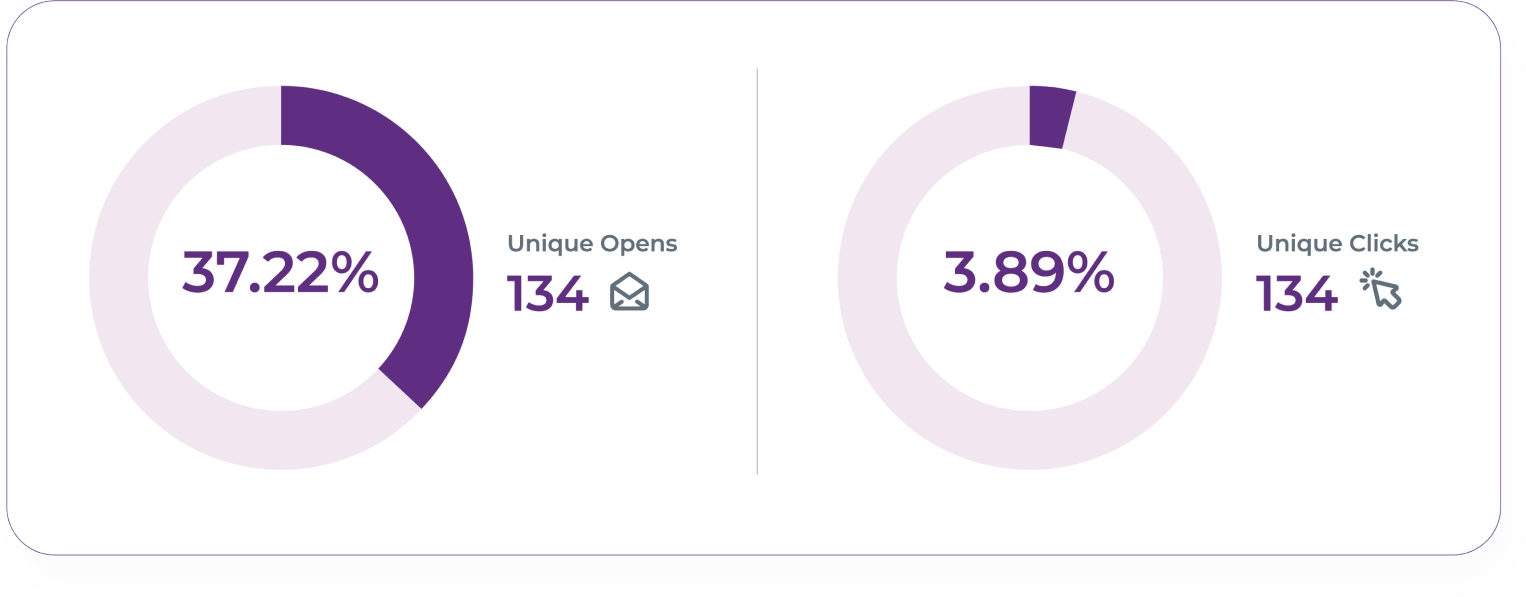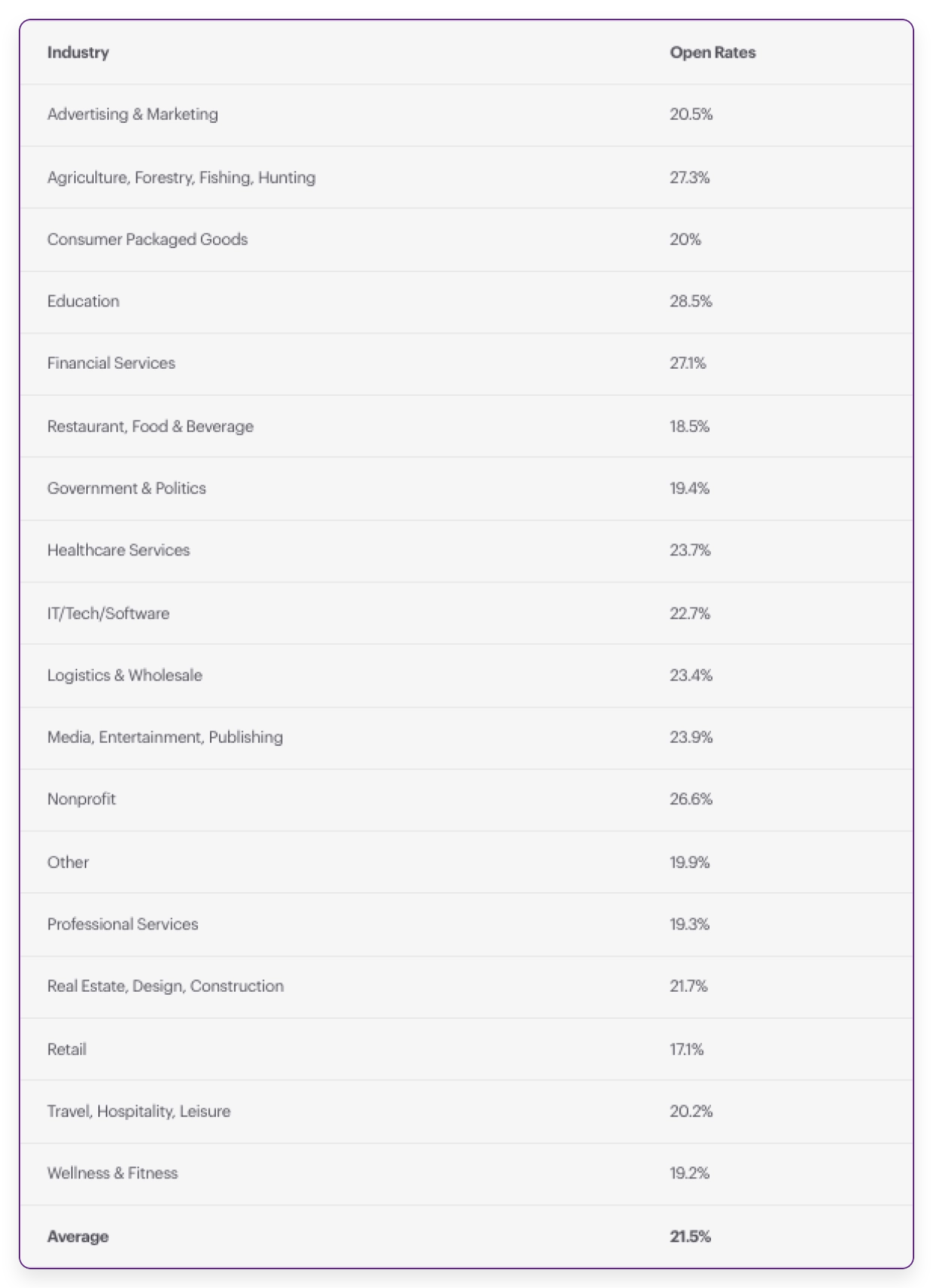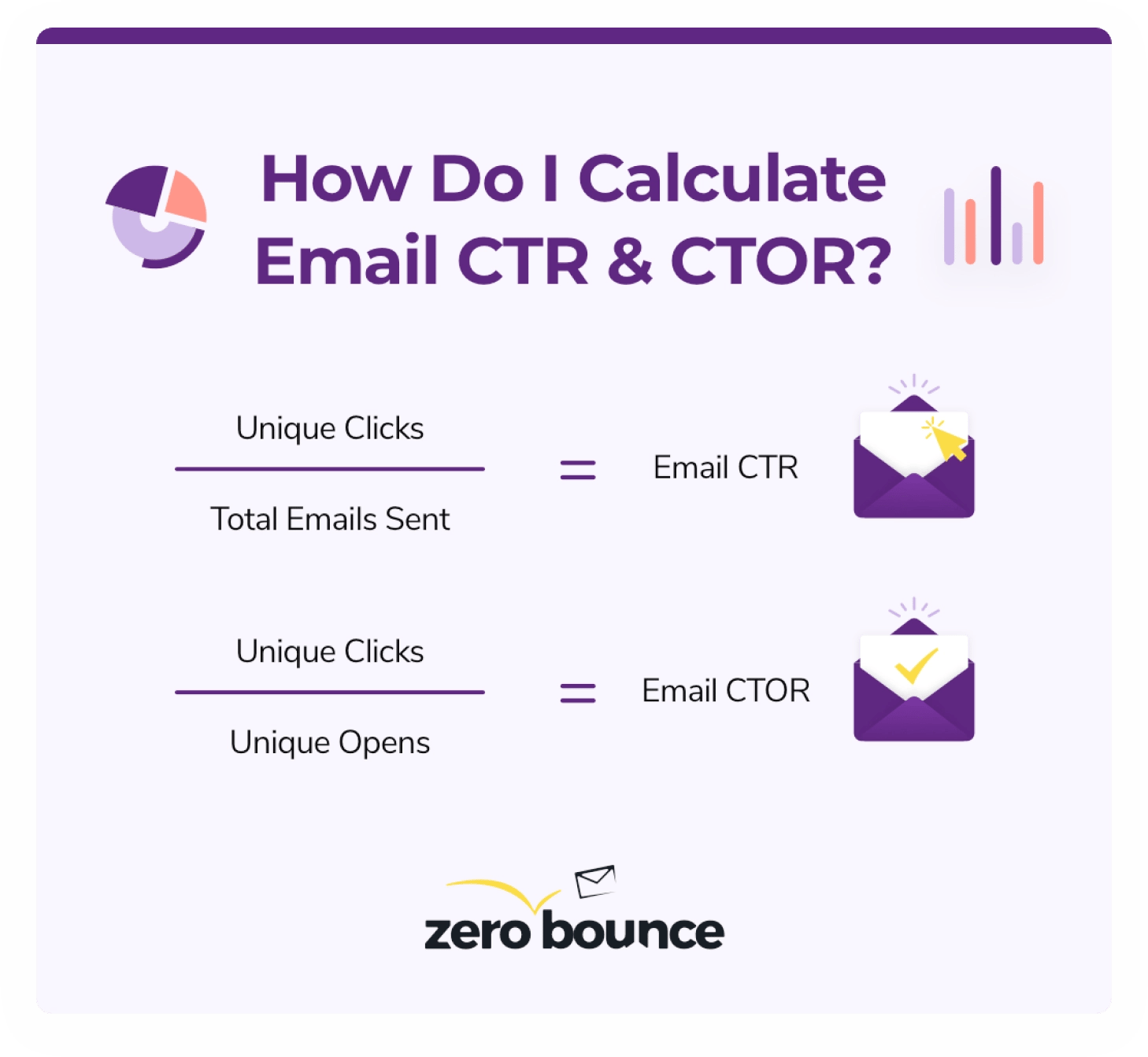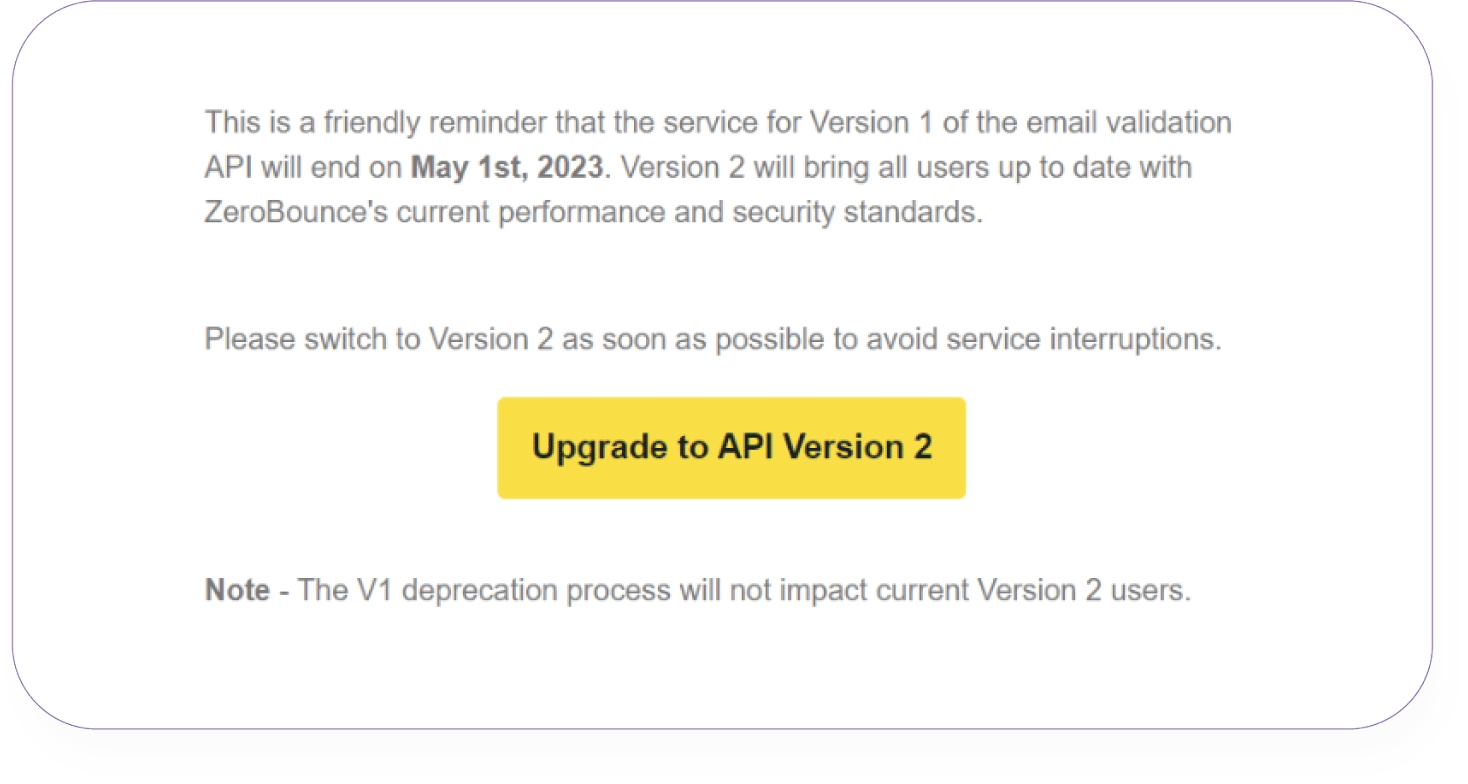
Click-to-Open Rate Calculator
Want to find the click-to-open rate (CTOR) for your email campaigns? Use our free CTOR calculator to see how well your email campaigns and newsletters perform.
Try it now ➔
Click-to-Open Rate Calculator


What is click-to-open rate?
Click-to-open ratio describes the percentage of your emails that receive a click after a subscriber opens it. It not only helps you learn if readers are opening your messages but if they are actively reading and engaging with the content inside.
Email CTOR is an excellent way to gain insight into how effective your emails are in helping you achieve specific marketing goals. For example, if the purpose of a campaign is to drive sales of a particular product, click-to-opens will tell you if subscribers are checking out the product or service as a result of the email.

How to use the CTOR calculator
To use the free CTOR calculator, follow these steps:
- Enter the number of emails you sent in your email campaign or newsletter in the first field.
- Enter the number of unique clicks received during the campaign.
 Unique clicks help you identify the number of unique persons that click a link in one of your emails. Compare this total clicks, which counts repeat clicks from the same persons. Your email service provider will distinguish between the two.
Unique clicks help you identify the number of unique persons that click a link in one of your emails. Compare this total clicks, which counts repeat clicks from the same persons. Your email service provider will distinguish between the two. - Enter the number of unique opens.
Similar to unique clicks, you want to count the number of unique individuals opening your emails. - Finally, click Calculate.
How to calculate click-to-open rate
You can use the following click-to-open rate calculation to find your CTOR for email at any time:
(unique email clicks / unique email opens) x 100 = CTOR
You should utilize unique numbers for both metrics in the CTOR formula to gain a better understanding of how many people you reach and convert. Total numbers will count repeat visitors and clicks, which leads to an inflated number and the impression that your email campaigns perform better than what your revenue will show.
What is the industry standard for click-to-open rate?
After you calculate click-to-open rate for your emails, you’ll want to see how your brand stacks up against industry standards.
Email CTOR can vary noticeably depending on your industry and the specific goals you’re trying to achieve with a particular email campaign. With that said, the average across all sectors is roughly 11%.

Achieving a satisfactory CTOR ratio is difficult. It can be tough to earn opens alone without a strong email marketing strategy, and getting readers to click takes the task one step further. Compare your email CTOR with your industry average to determine if you need to investigate additional marketing strategies.
How does CTOR compare to other email marketing metrics?
To better understand your CTOR calculation, let’s look at other vital email marketing metrics that play a role in your campaigns.
Email open rate
Email open rate is the percentage at which subscribers open your emails versus the number sent. You’ll always need to keep track of opens when monitoring campaigns and calculating other marketing metrics.
Email click rate
Email click rate is the percentage of subscribers clicking a link with an email versus the number sent. This can include image or hyperlink clicks.
Clickthrough rate
Clickthrough rate (CTR) is the easiest to confuse with CTOR. Let’s look at the email CTR formula to understand the distinction better.

Calculate email clickthrough rate with this formula
(unique email clicks / total emails sent) x 100 = CTR
Compare this to the email click-to-open rate formula, which is
(unique email clicks / unique opens) x 100 = CTOR
In other words, CTR counts how many link clicks you receive from subscribers, including those from repeat openers. CTOR indicates how effectively your emails attract a unique click following a unique open.
Both have their unique uses. CTR gives an honest representation of your email campaign’s overall effectiveness. Even if a click, and later a sale, comes from a repeat person, it’s a success.
Meanwhile, CTOR can provide a strong indication of your content’s effectiveness. If your CTOR is low, it can indicate that components of the content (the messaging, the offer, etc.) could be better. Conversely, a great offer and strong supporting content should motivate a click immediately following a unique open, leading to better email CTOR.
Bounce rate
Finally, email bounce rateⓘThe percentage of emails that are undelivered vs. delivered to the intended recipient. is essential to track to improve your campaigns. If your emails fail to reach the inbox, your CTOR and CTR will plummet.
If your email marketing underperforms, check your bounce rate to diagnose deliverability issues as soon as possible.
How to improve a low click-to-open rate
Perhaps more than other email marketing metrics, CTOR reflects the quality of the content inside an email.
To enhance your email CTOR, take a look at the following areas.
Choose one message and stick to it
When using email for marketing, keep your message simple and direct.
The average person receives over 100 emails in a workday. When those people have a busy slate of work, meetings and more, they want to get through their inboxes quickly.
With that in mind, choose a topic for your email and make it quick. You don’t have much time to spend with your subscribers, so you must ensure they receive the message. Avoid this by making your content too long and too busy by including too much information.
Images speak louder than words
While a lengthy email is likely to lose a reader fast, a colorful, well-designed graphic can convey more and engage readers longer.

In this example, MarketingProfs communicates the essential details of their email upfront with a brief picture. It provides the event's name and a clear call to action while showing the date nearby. More content follows, but this opener gets the message across efficiently.
Try implementing graphics to convey or highlight the most crucial part of a message. Even if the reader skims past the text, their eyes will jump to the high-quality image and easily see your promotion or offer.
Make the link clear and visible
If you want to raise your email CTOR, make sure the link you’re tracking is clear and prominent.
For example, don’t make the mistake of leaving an essential link in the middle of a paragraph. When someone’s skimming the email, they’re almost certainly going to miss it. Instead, try these tactics:

Make your link prominent in the body to attract more attention and clicks.
- Don’t post plain links - optimize the hyperlink with a call to action
- Make the link text large and prominent
- Highlight links with an easy-to-see color
- Use buttons, icons, or images to highlight where to click
Validate your email list
Finally, be sure to validate your email list regularly to help boost your email marketing metrics.
By practicing proper email list hygieneⓘThe act of or ability to maintain an email list or database consisting of valid and active email addresses., you proactively identify and remove invalid and high-risk email addresses from your list that negatively impact your campaign performance. Invalid emails equate to high bounce rates, low open rates, and even lower CTR and CTOR rates.
To help you increase your email click-to-open rate, ZeroBounce’s email verification also includes Activity Data and Email ScoringⓘA ZeroBounce service that uses AI and proprietary technology to grade an email contact based on their likelihood to interact with an email and convert (most commonly used for catch-all email addresses)., which lets you know how engaged a user is with their email inbox. When subscribers show high activity levels, you can segment your campaign and target those users for the best performance results.
Try ZeroBounce email validationⓘA process that determines if an email address uses valid syntax, exists on a given domain, and is configured to receive incoming email messages today by creating your free account. Take advantage of 100 free monthly credits and score your contacts to improve your click-to-open rate like an email professional.
Try these free email deliverabilityⓘA sender’s ability to reach the recipient’s inbox with their outgoing emails. It may also describe the ratio of emails delivered to the inbox vs. those sent to spam or blocked by the receiving server. calculators
Frequently asked questions about CTOR
Email click-to-open rate is the percentage of unique email clicks versus unique email opens. It strongly indicates your email content’s effectiveness at driving action and conversions.
The average email click-to-open rate across all industries is about 11%.
Email clickthrough rate is the number of unique opens versus the total number of emails sent. Click-to-open rate is the number of unique email clicks versus the number of unique opens. While similar, both track different aspects of an email marketing campaign.
To improve your email CTOR:
- Focus on one topic or offer
- Keep the message clear and concise
- Make links prominent and visible
- Use eye-catching design and graphics
- Create a sense of urgency
- Highlight the value and benefits
The average email clickthrough rate across all industries is 2.3%.